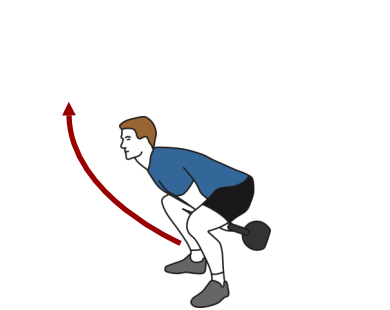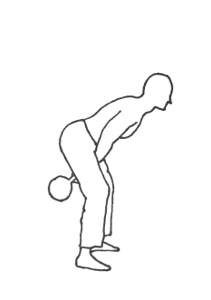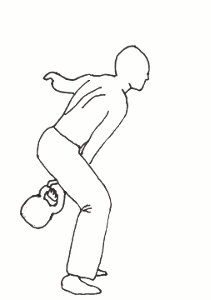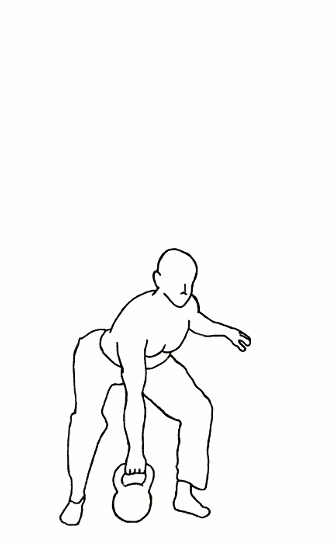

Kettlebell Swings
The Swing is the basic of all ballistic techniques. The key point is to move with your hips at the beginning of the movement through to the completion of the swing. The form is a loose to tight protocol. You start by swinging the kettlebell down between your legs and then swing the bell up to chest level by exploding with your hips while tightening your core by locking out your knees, pull up your thighs, tighten your gluts and your abs. Then swing the kettlebell back down between your legs and repeat. Learning the proper form of the swing is key in performing the other ballistic techniques.
The swing can be performed several different ways. Two of these ways are the Hard Style and the Soft Style. The main difference between hard and soft style is in the expression of the form. The hard style is explosive and is can be very exhausting very quickly. Think of this as a punch where you tense your body at the last second of the punch and transfer the power of your tension from your core out to the end of your punch. In the hard style you inhale as you swing down and exhale at the top of the swing. This breathing pattern adds to the explosive power at the top of the swing. In the soft style you are trying to do as many repetitions as you can, possibly hundreds of reps at a time. To do this, you change the way you breath as you do not want to generate the same explosive power. For the soft style you exhale on the down swing and inhale at the top of the swing. This is called matched breathing where you naturally exhale when your lungs are compressed and inhale on the expansion of the lung. All the other things are the same as the hard style except you do not create tension at the top of each swing. This will allow you to perform hundreds of repetitions at a time. The soft style is used in the competitive Girevoy sport of kettlebell lifting.
BEFORE YOU ATTEMPT THE SWING - You need to know how to safely pick up and put down the kettlebell. To practice this, stand with a box or chair behind you. Your feet should be "on rails" meaning your legs should be in line with your shoulders, your feet are flat and pointed straight ahead. Sit down by first sitting back with you hips, then bend your knees. Your hands should be hanging down in front of you between your legs. Your back should be straight or arched, do not round your back. When you are bending down or coming up, your knees should not go further then your toes, and your knees should track in line with your feet. Now stand back up by pushing through the heals of your feet, through your thighs and hips. Again keep your back straight, knees tracking in line with your feet and knees no further then your toes. At the top of the movement when you are standing straight, push through your hips and tighten your gluts, abs and thighs. Your knees are straight, hips are forward, and the back straight. Now you are ready to move on to the swing.
Preparing for the 2 Hand Swing - Stand with the kettlebell between your feet. The kettlebell should be positioned with the handle going left to right between your legs. Using the form described above, bend down and pick up the kettlebell by the top handle with both hands. Your fingers should naturally wrap around the handle with the back of your hands pointed to the wall in front of you. Stand straight up. The kettlebell should be hanging down the center of your body. You are finally ready to start the swing. This is one of the the easiest and safest ways to learn how to prepare for the swing. There are others ways to prepare for the swing. The differences are how the kettlebell is taken off of the floor. One is where a short back swing is performed right from the floor as you stand up into the swing. The other is where the kettlebell is set far back between your legs so no back swing is necessary and you swing up right from the bottom. We use all of these prep techniques depending on the size of the kettlebell and the technique being performed.
The 2 Hand Swing
The 2 Hand Swing - Move your hips back and let your arms swing backwards and the kettlebell will swing back between your legs. You are not swinging the kettlebell down and up with your arms. Your arms should act as a pendulum only and not push down or pull up the weight. This is not a weight lifting technique. It is a swing that focuses on your core, not your arms. As you do this back movement, take a inhalation breath. You should not be bending deeply with your knees. The knees do bend but the focus is through the hips. As you swing the kettlebell backwards the inside of your forearms should touch the inside of your thighs and let the bell swing backwards. You should have a relatively loose grip on the kettlebell. Now explode or 'pop' your hips forward. Snap the hips by contracting the gluteus explosively simulating the action of a vertical jump without the jump. Project the kettlebell straight ahead with the power of the hips. Exhale your breath with force at the top of the swing. Time it so you exhale explosively while tightening your core all at the top of the swing. Your back should be straight. Do not pull back with your shoulders, do not lean back and do not pull the kettlebell up with your arms. You will only develop bad form and could potentially hurt yourself. Let the power come from your hips, not your upper back or arms. Now relax the tension and inhale while you let the kettlebell drop backwards between your legs. Use your hips to start this backwards movement. If you are performing the swing correctly, meaning at the top of the swing your body is straight and upright, your knees are straight, thighs pulled up, gluts tight and abs tight, then you should have a vibration that will shake through your legs. This happens when you have the right tension. If you do not engage the tension correctly you will not have this vibration in the legs.
Initially on your first few swings might end with the kettlebell below your waist. As you continue to swing, keep swinging higher until you reach shoulder height. The height of the kettlebell can vary to anywhere from your waist, chest, or above your head. Because the explosive style described above you will become exhausted very quickly. This is not uncommon when performing the swing correctly. You will build overall strength and endurance performing the swing.
The 1 Hand Swing - The 1 hand swing is performed the same way as the 2 hand swing. Other then the obvious difference that it is performed with one hand instead of two there is a minor difference that you can choose to perform on this swing. As you swing the kettlebell backwards between your legs you can rotate your hand 90 degrees so your thumb is pointing backwards. This will turn the handle so it is perpendicular to your body. Doing this, you will not have to open your legs wide on the back swing. As the kettlebell comes to the top of the swing, rotate your hand to the starting position where the back of your hand is facing up. We have performed the 1 hand swing with the hand flat while swinging as well as rotating the thumb backwards. Both work. It will become more evident as to why you would want to rotate your hand in the power swing.
The Power Swing - The power swing means you are swinging 2 kettlebells, one in each hand. The technique is performed exactly like the 1 hand swing. Now you will understand why we rotate our hand at the bottom of the swing. If we did not, we would have to take a wide stance to get both kettlebells between the legs. There is nothing wrong with performing it with a wide stance without rotating your hands, so try both versions. See which you like better.
Overhead Swing
The High Swing is just like the basic two handed swing except the kettlebell is halted over the head for a predetermined time period. In the Basic Swing the kettlebell is not stopped at its apex whatever height you are working at. This is not the case with the High Swing Overhead. Use caution on the down swing of the kettlebell. Bend your knees and flow with the bell. We do not advise this being done as a single hand swing, it is to risky. From the finished position with the kettlebell overhead you can add a squat keeping the bell overhead, do a press, body twists left and right, 180 turns on walking swings, or just keep swinging.

Kettlebell Clean
The Clean is a modified swing where near the top of the swing the elbow bends and brings the fist to the shoulder while rotating the kettlebell over to the back of the hand bringing the bell to rest in the final position on the outside of the arm. This is performed in one flowing or "clean" motion. Start the same way you start a swing. All the same rules apply. As you start to swing the kettlebell up, bend or "break" the swing at the elbow when the arm is little higher then waist level.
While breaking the elbow bring the hand up to the shoulder. Do this by rotating the fist of the hand up to the shoulder. Make a fist and look at the side of your fist where the thumb is wrapped around the index finger. This is the part of the fist that should move toward the shoulder. Of course your hand will never reach your shoulder but use that imagery when bringing the arm up. The bottom of your fist will face away from you pointing directly in front of you. When you rotate the fist up, this produces a cork screw effect of the hand and the kettlebell will rotate over to the back of your hand resting on the outside of your arm. At the final position of the movement, the arm is in a vertical position from the elbow to the hand with the inside of the upper arm and elbow held tightly against your ribs. The kettlebell will end up on the outside of the body against your biceps, shoulder and forearm. The shoulder is packed.
You will know immediately if you do not perform the clean correctly as you will end up slapping the kettlebell against the outside of the forearm of the arm. Good technique is key to efficient and painless shock absorption. Doing the form incorrectly will leave you with a nice bruise on the arm the next day. This means you are not correctly turning your hand to your shoulder. Instead the kettlebell is coming directly over the top of the hand and slamming into the arm. You can slow it down and prevent it from slamming the arm by squeezing the kettlebell with the hand as it comes over the top, but you will only be able to do this with a light bell, and the technique is incorrect. Another mistake is to let the kettlebell pull down outside of your body, making your elbow move up and inside your body at a 45 degree angle. If you are doing this, you are not stopping the hand vertically at the shoulder and you can injury your shoulder, your elbow or both. At the top of the clean, stop for a moment and then either push the kettlebell out and let it fall down or drop down in an arch and let it swing down back between your leg, continue on the up swing etc.
You should not have any wrists in this technique, meaning here should be a straight line from your knuckles through the wrist to your forearm. In other words, do not bend your wrists. Your whole body should work as one and not employ the muscles of the shoulder or arm to bring the kettlebell up. Take advantage of the ballistic motion of the swing to bring the kettlebell to it's resting place. Remember to start the motion with your hips. At no point lean back or pull back with your shoulders. Always keep your back straight or arched but never rounded.
There are several other ways to perform the clean. One is a dipping technique where you dip your knees and get under the kettlebell right before the kettlebell reaches your shoulder. Then you stand up to the final position. This helps your body absorb the weight of the kettlebell against your body. We use this technique when we use a very heavy kettlebell.
Another technique that is slightly different is where the kettlebell comes to rest on top of the inside of the arm. The ball rests on the top of your biceps/shoulder instead of on the outside of the arm. This is used in the Girevoy sport of kettlebell lifting. You can also use the pinch grip or move your grip to the corner of where the handle and horn attach.

Kettlebell Snatch - Basic Technique
Before performing the Snatch you should be proficient in the Swing, the Clean and the Press. The Snatch is a modified swing where as the kettlebell swings up above the head, the bell flips over the hand and ends up in the same overhead position as the press. Start by performing the Snatch as you would the Swing, there is no difference at all. As the kettlebell raises up over the head, do a slight corkscrew with the hand so the bell flips directly over the hand. Do this in one complete fluid motion. The fingers of the hand doing the Snatch can be left open at the top of the movement, or you can close them around the handle. Image as if you are putting you hand in a glove over your head. The lift of the bell coming up is with the hips once again and not the arms. The kettlebell comes to rest overhead in the same position as the press, elbow locked out, shoulder packed.
To repeat another snatch bring the arm down in two different ways. One is the same as a swing moving down where the kettlebell will come over the top of the hand and the entire arm will swing down between your legs. The other is a corkscrew down movement where the arm is rotated in a reverse corkscrew pattern to the inside of the body and drops in and arc backward so it can swing back up from the bottom. As in most techniques the variations are endless, such as Power Snatches (two kettlebells), bottoms up, standing on blocks for a deeper squats, etc.
True Snatch
The True Snatch is the original snatch technique that was changed to the snatch we show above. Perform this from the Olympic position. Using either one or two hands the kettlebell is pulled straight up from the floor and over head without flipping the kettlebell over the hand. The bell ends up in a bottom down position in front of the arm. This will challenge your thumb gripping so be careful. Keep the kettlebell close to the body when bringing it up. There is no swing here so it is similar to the Olympic Press where you explode from the floor. As always, keep the shoulders packed and down. Avoid the use of the top of the shoulders to lift. Do not shrug your shoulders.
Kettlebell Press
The Press starts standing with the kettlebell in the rack (Cleaned) position. Get the arm into this position by cleaning the kettlebell or using any number of other techniques. Take a breath of air in, then lock it down and start to exhale as you press the kettlebell up overhead until the elbow locks at the top. The arm should not come out to the side, but instead go up in an slightly elliptical arc. The elbow will rotate up and out with it pointing outside the body at the lock out position. The arm will rotate with the elbow and the base of your your palm will face forward at the extension. The arm should be pulled back in line from the ear to the biceps with space between the neck and the shoulder. Do not overextend your shoulder, keep it packed. To bring the kettlebell back down, take another breath in. Start to exhale and rotate the elbow inside and down while you actively pull the kettlebell down. Do not let arm fall into the rack instead pull the weight down with tension until the bell is back in the rack. The most important thing to remember is to keep the shoulder packed.
Kettlebell Release and Catch
In the Release & Catch the hand releases the kettlebell near the apex of the swing and is replaced by the free hand. As you swing the kettlebell up, bring the free arm up at the same time. At the apex of the swing place the free hand over the fingers of the hand holding the kettlebell. Move the hand holding the kettlebell away, and grasp with the hand that was left in its place. Swing the kettlebell down and continue.
DansFitness.Org is fully licensed, insured and authorized to conduct business in the United States.